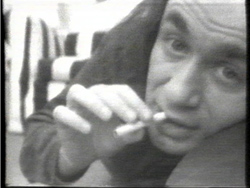 |
||||
INTRODUCTION
|
EXHIBITION: PERFORMANCE |
|||
 Image: Vito Acconci, “Theme Song,” 1973. Courtesy Video Data Bank, Chicago. Text: VDB Online catalogue: http://www.vdb.org. Reprinted with permission by VDB. . |
Vito Acconci: Theme Song In a vile and ingenious way, Acconci pleads with the camera/spectator to join with him, to come to him, promising to be honest and begging, “I need it, you need it, c’mon... look how easy it is.” Acconci addresses the viewer as a sexual partner, acting as if no distance existed between them. The monitor becomes an agent of intimate address, presenting a disingenuous intimacy that is one-sided and pure fantasy, much like the popular love songs in the background with which Acconci croons, “I’ll be your baby, I’ll be your baby tonight, yeah, yeah.” Biography: A poet of the New York school in the 1960s, Acconci moved toward performance, sound, and video work by the end of the decade. Acconci changed direction in order to “define [his] body in space, find a ground for [him]self, an alternate ground for the page ground [he] had as a poet.” Acconci’s early performances were extremely controversial, transgressing assumed boundaries between public and private space, and between audience and performer. Positioning his own body as the simultaneous subject and object of the work, Acconci’s early video tapes took advantage of the medium’s self-reflexive potential in mediating his own and the viewer’s attention. Consistently exploring the dynamics of intimacy, trust, and power, the focus of Acconci’s projects gradually moved from his physical body toward the psychology of interpersonal transactions, and later, to the cultural and political implications of the performative space he set up for the camera. |
|||
 Image: Joan Jonas, “Vertical Roll,” 1972. Courtesy Video Data Bank, Chicago. Text: VDB online catalogue: http://www.vdb.org. Reprinted with permission by VDB. |
Joan Jonas: Vertical Roll In this well-known tape, Jonas manipulates the grammar of the camera to create the sense of a grossly disturbed physical space. The space functions as a metaphor for the unstable identity of the costumed and masked female figure roaming the screen, negotiating the rolling barrier of the screen’s bottom edge. Vertical Roll draws on the essential connection between performance art and the video monitor, as time-based media especially suited to materializing the artist’s psyche. Exploring the dislocation of physical space and mythical female archetypes, Jonas’s work occupies an important position in the development of both early formalist and early feminist video. Biography: Joan Jonas studied sculpture and art history at Columbia University and Mount Holyoke College, and dance with Tricia Brown at the Boston Museum school. Widely known for her work in performance in the mid-60s, Jonas first incorporated a live video camera and monitor into a 1972 performance, Organic Honey’s Visual Telepathy. In the same year, she began producing single-channel tapes, among them Vertical Roll (1972), which are recognized as landmark investigations into the structural and performative nature of the medium. |
|||
 |
||||